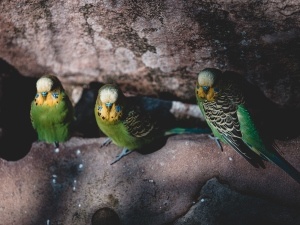
If you’re a bird owner you likely treat your birds very well, the bird likely gets the correct foods, is bathed on a regular basis, the bird likely has many toys to play with, and you are likely keeping a very close eye on the bird
If you’re keeping a close eye on your bird you’ll quickly notice if something is off with the bird, like brown spots developing on your budgie’s beak
This article looks into why this may be happening
Table of Contents
Brown spot on budgies beak:
The beak is a very vital part of your bird’s body, without it the bird isn’t able to eat, this is why beak health is so important.
If your budgie’s beak starts to look brown you’d be right to be worried, here are reasons why this may be happening:
A bruise:
Your bird’s beak can bruise just as any other part of the bird’s body can. To understand how your bird’s beak can develop a bruise you’d need to understand what your bird’s beak is made up of.
The outer layer of your bird’s beak is made out of keratin, keratin is what makes up not only a bird’s beak but also human fingernails, human hair, and part of your skin.
The beak is also made up of bone, tissue, and a layer of blood vessels called capillaries which deliver blood to the beak. These blood vessels are fragile.
If the beak sustains an injury, if the bird flies into a window or door, if the bird flies into a ceiling fan, or if the bird gets into a fight with another bird and the beak is struck then the trauma can break the capillaries which will release blood and this blood will pool.
The pool of blood will start off red then get darker to brown and then turn black as time passes.
What to do:
If the bird is acting normally, if it is not in distress and is eating, playing, and behaving normally overall then the bruise is likely not painful to the bird and the bird can continue its everyday normal functions.
The bruise will go away in a little while so you don’t have to worry.
The blood won’t recede back into the bird’s beak, the beak will continue to grow and the spot will grow along with the beak.
Once the brown spot reaches the tip of the beak the bird will file the beak down as it normally does and the brown spot will disappear
We recommend that you make an appointment with, and take your bird to the vet if the bird is unable to eat, this means that the bird is in a lot of pain and needs to be prescribed medications.
Fatty liver disease:
If your bird hasn’t suffered an injury, then the brown spot may not be a bruise but a blood clot, if this is the case then the bird may have fatty liver disease also called hepatic lipidosis
If the bird eats a high-fat diet, like a seed diet, then the bird will develop an accumulation of fat around its liver.
The bird’s liver may start to malfunction and cause blood clots to form.
The blood clots can develop anywhere in your bird’s body and your bird may suffer from these blood clots in the blood vessels of the beak
What to do:
Taking your bird to the vet is recommended. Birds who suffer from this condition should be put on a low-fat diet and your vet may also suggest supportive care and other treatments.
If you leave the bird and do not give it treatment for too long then the bids liver condition will worsen and the bird’s health will quickly decline, to a point where you can’t do anything about it anymore.
If you enjoyed this article then you may also be interested in other bird related articles. Here are some articles that you may be interested in: Black Spots On Cockatiel Beak, Red Spot On Budgies Beak, Black Spot On Parakeets Beak, Stripes On Cockatiel Beak, Why Is My Ringnecks Beak Black?


